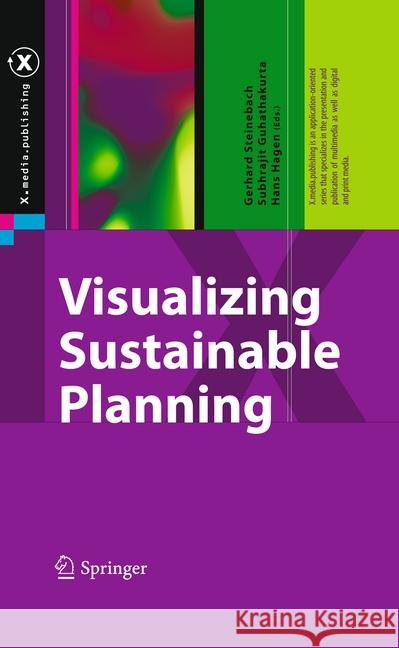Visualizing Sustainable Planning » książka



Visualizing Sustainable Planning
ISBN-13: 9783662518991 / Angielski / Miękka / 2016 / 262 str.
Visualizing Sustainable Planning
ISBN-13: 9783662518991 / Angielski / Miękka / 2016 / 262 str.
(netto: 465,75 VAT: 5%)
Najniższa cena z 30 dni: 468,37
ok. 22 dni roboczych.
Darmowa dostawa!
This volume presents the state of the art in the rapidly growing field of visualization as related to problems in urban and regional planning. It brings together a rich compendium of visualization tools.
Planning.- Planning Sustainable Living.- Visualizing Planning for a Sustainable World.- GIS-based Applications and the English Planning System: Modeling Town Centers and Housing Potential.- Monitoring the Effective and Efficient Use of Land: The English Approach.- Augmented Reality and Immersive Scenarios in Urban Planning.- Environmental Issues.- Urban Meteorological Modeling.- Urban Drainage Modeling and Flood Risk Management.- Environmental Noise.- Work-Facilitating Information Visualization Techniques for Complex Wastewater Systems.- Simulation and Visualization of Indoor Acoustics Using Phonon Tracing.- Case Study.- Digital Phoenix Project: A Multidimensional Journey through Time.- PhD-Theses.- Estimating Residential Building Types from Demographic Information at a Neighborhood Scale.- Visualization of Sustainability Indicators: A Conceptual Framework.- Modeling Dynamic Land-Use Transition for Transportation Sustainability.- Sustainable Phoenix: Lessons from the Dutch Model.- Toward Dynamic Real-Time Informative Warning Systems.
Prof. Dr. Hans Hagen:
March 1982: PhD (Mathematics), University of Dortmund
1983-1986: Assistant Professor at Arizona State University
1986-1988: Professor (C3), TU Braunschweig
since 1988: Professor (C4), University of Kaiserslautern
Hans Hagen is heading the research group for Computer Graphics and Computer Geometry at University of Kaiserslautern, Germany. He is both national and international a pioneer in his research domains geometric modeling and scientific visualization.
Prof. Dr. Subhrajit Guhathakurta:
1987: MCRP, Community and Regional Planning, Iowa State University, Ames, Iowa
1991: Ph. D., City and Regional Planning, University of California, Berkeley
1992-93: Visiting Assistant Professor of Community and Regional Planning, Iowa State University, Ames
1993-94: Research Associate, Center for Real Estate and Urban Economics and Institute of Urban and Regional Development, UC Berkeley
1994-2000: Assistant Professor, School of Planning and Landscape Architecture, Arizona State University
Mar-Jun 2000: Visiting Faculty, School of Geographical Sciences and Planning, University of Queensland, Brisbane, Australia
Oct 2000-Jan 2001: Visiting Faculty, Indian Institute of Information Technology, Bangalore, India
since 2000: Associate Professor, School of Planning and Landscape Architecture, Arizona State University
Prof. Guhathakurta has developed a keen interest in urban modeling since his involvement with Prof. John Landis at UC Berkeley and the California Urban Futures Modeling effort.
Prof. Dr.-Ing. Gerhard Steinebach:
1979: Received ‘Diploma Spatial and Environmental Planning’ (Dipl.-Ing. Raum- und Umweltplanung) at University of Kaiserslautern
1979-1987: Research Assistant, University of Kaiserslautern
1987: PhD (Dr.-Ing. Raum- und Umweltplanung), University of Kaiserslautern
1988-2000: Co-Founder and Managing Director of ‘Forschungs- und Informationsgesellschaft der Raum- und Umweltplanung (FIRU)’
1997-1999: Visiting Professor, University of Kaiserslautern
Since 1999: Professor (C4), University of Kaiserslautern
Gerhard Steinebach is a recognized expert in his research domains: ‘Urban ecology - focusing on the environmental impacts of development’, ‘Conversion of military and industrial brownfields’ and ‘Management of planning procedures’.
The authors present the state of the art in the rapidly growing field of visualization as related to problems in urban and regional planning. The significance and timeliness of this volume consist in its reflection of several developments in literature and the challenges cities are facing. First, the unsustainability of many of our current paradigms of development has become evidently clear. We are entering an era in which communities across the globe are strengthening their connections to the global flows of capital, goods, ideas, technologies and values while facing at the same time serious dislocations in their traditional socioeconomic structures. While the impending scenarios of climate change impacts remind us about the integrated ecological system that we are part of, the current discussions about global recession in the media alert us and make us aware of the occasional perils of the globalized economic system. The globally dispersed, intricately integrated and hyper-complex socioeconomic-ecological system is difficult to analyze, comprehend and communicate without effective visualization tools. Given that planners are at the frontlines in the effort to prepare as well as build resilience in the impacted communities, appropriate visualization tools are indispensable for effective planning. Second, planners have largely been slow to incorporate the advances in visualization research emerging from other domains of inquiry. Findings of research in other disciplines, such as graphic design, geography and cartography also lead to the development of new forms of visualization and communication.
1997-2026 DolnySlask.com Agencja Internetowa
KrainaKsiazek.PL - Księgarnia Internetowa









